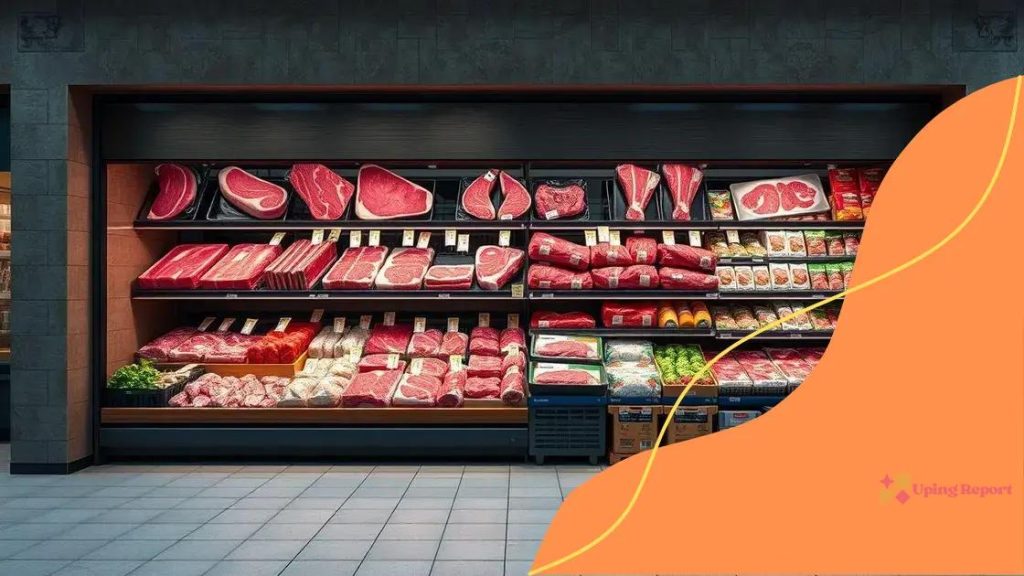US beef export increase: what it means for consumers

The increase in US beef exports enhances consumer access to diverse, high-quality beef products while presenting challenges such as regulatory compliance and market competition for exporters.
The recent US beef export increase is a hot topic that could change your shopping experience and the prices you pay. Have you wondered how this shift impacts your plate? Let’s dive into the details.
Current trends in US beef exports
As we explore the current trends in US beef exports, it’s essential to understand how these shifts influence the agricultural and economic landscape. The United States has been a major player in the beef export market, showcasing high-quality products that appeal to international consumers.
Factors Driving Export Growth
Several factors contribute to the increase in beef exports from the US. First, the demand for premium beef cuts is rising globally. Countries like Japan, South Korea, and China are frequently seeking out high-quality beef, leading to expansion opportunities for US producers. Additionally, trade agreements have opened doors, making it easier for American beef to enter new markets.
- Increased global demand for quality beef.
- Trade agreements facilitating easier market access.
- Strong marketing efforts by US beef organizations.
Another aspect influencing beef exports is the consistency and safety of US beef products. Consumers abroad have come to trust the rigorous safety standards upheld by the US Department of Agriculture. This trust leads to stronger relationships between US producers and international buyers, further bolstering export levels.
Challenges and Opportunities
Despite the positive trajectory, the US beef export market also faces challenges. International competition is intensifying as countries like Australia and Brazil ramp up their beef production and export efforts. However, this competition can spur innovation among US producers, driving them to improve quality and reduce costs.
- Emerging competitors in the global market.
- Innovation as a response to competition.
- Need for sustainable practices in beef production.
As the market continues to evolve, US beef exporters need to adapt quickly. Building strong relationships with overseas partners and staying informed about consumer preferences will be crucial. The future looks promising, and US beef can maintain a competitive edge with its rich flavor and high standards.
Impact of increased exports on domestic market
The impact of increased exports on the domestic market is a significant aspect of the current beef industry landscape. As the US beef export levels rise, both producers and consumers in the local market notice various effects.
Price Fluctuations
One notable impact is on beef prices. As demand for US beef rises internationally, local prices can also change. Increased exports often mean higher prices at the supermarket. When international markets offer better prices to producers, they might prioritize export over domestic sales.
- Potential increase in local beef prices.
- Producers may favor export markets.
- Variability based on supply and demand.
These price fluctuations can lead to mixed reactions from consumers. While higher prices can mean better quality, they may also strain household budgets. Understanding the balance between exports and local availability is crucial for consumers.
Supply Availability
Another effect of rising exports is on the availability of beef in local markets. With a portion of the beef production shipped overseas, there may be less beef available for domestic consumers. This can lead to competition among local buyers, creating scenarios where some cuts may be harder to find.
- Possible shortages of certain beef cuts.
- Increased competition among consumers.
- Producers adjusting availability based on demand.
While the overall growth in demand for US beef can be beneficial for farmers, it’s essential to address how it reshapes the local market landscape. As exports rise, awareness of these changes can help consumers better navigate their shopping experiences and expectations regarding beef prices and availability.
How US beef holds up worldwide

Understanding how US beef holds up worldwide is vital for both consumers and producers. The quality and reputation of US beef continue to play a significant role in its acceptance across global markets.
Quality Standards
One reason for the strong international presence of US beef is the stringent quality standards. The US Department of Agriculture (USDA) ensures that beef is produced, processed, and inspected under strict guidelines. This commitment to quality results in a product that is highly valued by consumers around the world.
- Strict USDA inspection processes.
- High-quality feeding practices for cattle.
- Safety regulations that protect consumers.
Additionally, practices like grain-fed diets contribute to flavorful cuts. This superior taste appeals to international markets, allowing US beef to maintain a competitive edge.
Global Competition
The beef market is competitive, with countries like Australia and Brazil also striving for access to international consumers. However, US beef benefits from a strong brand reputation and extensive marketing efforts. Programs highlighting the unique flavors and quality of American beef help to promote it in various regions.
- Strong marketing strategies targeting global consumers.
- Competitive pricing models to attract buyers.
- Leveraging consumer feedback for continuous improvement.
Moreover, trade agreements facilitate easier access to foreign markets. This framework allows US producers to expand their reach, showcasing their high-quality beef to diverse consumer bases.
Consumer Preferences
As global tastes evolve, understanding consumer preferences is critical. Many international consumers are looking for high-quality, sustainable beef options. The US beef industry is responding by adapting practices to meet these demands, ensuring that US beef remains a favorite abroad.
- Focus on sustainable farming and ranching.
- Emphasizing animal welfare standards.
- Adapting to dietary demands for leaner cuts.
By keeping pace with trends and maintaining quality, US beef can continue its success in the global market.
Consumer benefits of rising beef exports
The consumer benefits of rising beef exports are significant and multifaceted. As US beef exports increase, consumers can enjoy a variety of advantages that enhance their shopping experience and dining options.
Diverse Options
One major benefit is the increased variety of beef products available on the market. With rising exports, retailers can offer a broader selection of cuts and brands. This diversity makes it easier for consumers to find their preferred styles of beef, whether they seek premium cuts, organic options, or specific regional varieties.
- Enhanced availability of specialty cuts.
- Broader selection of beef products from different regions.
- Opportunities to try international beef brands.
Access to different beef products allows consumers to experiment with various recipes and cuisines, enriching their dining experiences.
Potential Cost Savings
Increased competition from exports can also lead to potential cost savings. As US beef competes in international markets, producers may streamline their operations to maintain price competitiveness. This can result in lower prices for domestic consumers as producers look to attract local buyers while keeping costs down.
- Reduced prices due to competitive market dynamics.
- Possibility of sales and promotions from retailers.
- Consumer-driven price benefits as demand fluctuates.
As prices become more favorable, consumers can take advantage of these savings by purchasing higher quality beef without breaking the bank.
Higher Quality Assurance
Another benefit of rising beef exports is the confidence in quality. The US beef industry adheres to strict safety and quality standards, which reassures consumers. As US beef gains international recognition, consumers benefit from a trusted source of high-quality meat.
- Strict USDA guidelines ensure safety and quality.
- Maintained reputation enhances consumer trust.
- Higher standards contribute to better-tasting beef.
This assurance enables consumers to confidently purchase beef, knowing they are getting a reliable and delicious product. As exports rise, consumers can enjoy not only a more extensive selection but also the satisfaction that comes from choosing a high-quality food source.
Challenges faced by beef exporters
The challenges faced by beef exporters are complex and varied. As the global market for beef evolves, exporters must navigate numerous obstacles that can impact their success.
Regulatory Hurdles
One of the primary challenges is dealing with different regulations in foreign markets. Each country has its own set of rules regarding beef imports, and compliance can be costly and time-consuming. Exporters must ensure they meet health, safety, and labeling requirements, which often vary significantly.
- Complex import regulations in each country.
- Costs associated with meeting food safety standards.
- Potential for delays in the export process due to inspections.
These regulatory hurdles can create barriers that slow down the shipping of beef, affecting overall profits and market access.
Market Competition
Another major hurdle is intense competition from other beef-exporting nations. Countries like Brazil and Australia offer their products at competitive prices, making it challenging for US exporters. Maintaining a competitive edge is crucial, and producers must work hard to differentiate their beef through quality and marketing.
- Pressure from cheaper beef imports.
- Heading demands in markets with established competitors.
- Need for continuous innovation in production and packaging.
Innovative marketing and high-quality offerings are essential to ensure that US beef stands out in this crowded market.
Logistical Challenges
The logistics of exporting beef can be another complicated area. Get beef from the farm to international markets requires a well-coordinated supply chain. Issues such as transportation costs, shipping times, and handling can affect the quality of the beef as well. Ensuring efficient, reliable shipping is essential for maintaining the product’s quality.
- High transportation and shipping costs.
- Risk of spoilage during transit.
- Importance of reliable logistics partners.
Ultimately, addressing these logistical challenges is crucial for beef exporters to remain competitive in the global market.
FAQ – Frequently Asked Questions about US Beef Exports
What are the main benefits of rising US beef exports?
Rising US beef exports provide consumers with more choices, potentially lower prices, and greater access to high-quality beef.
What challenges do US beef exporters face?
US beef exporters deal with regulatory hurdles, market competition, and logistical challenges that can impact their ability to sell internationally.
How do international regulations affect beef exports?
Different countries have varying import regulations, which can require exporters to meet specific health and safety standards.
What impact do competition and pricing have on consumers?
Increased competition from countries like Brazil and Australia can lead to lower prices and better quality for consumers in the US market.
